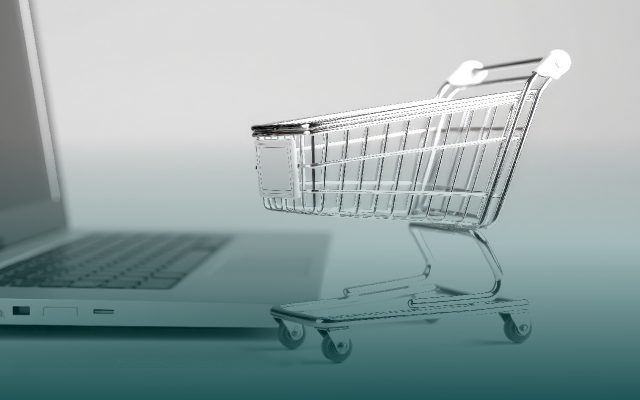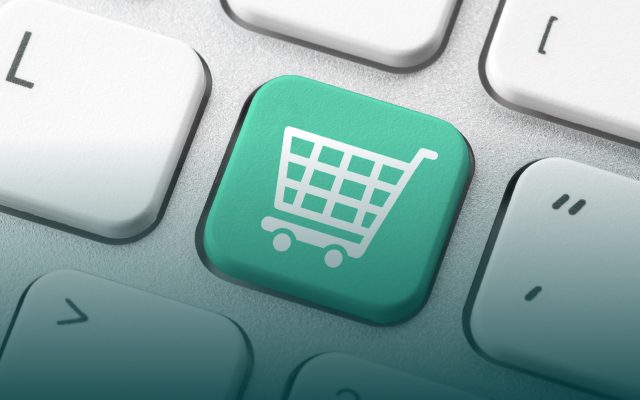High chances are that you have been in the role of an ecommerce client at least once in your life. Suppose that you want to buy a new book and check its availability online. You go to the website of a bookstore in your city, search for the needed book, and see that it’s in stock. You decide to save money on delivery and go to the store to buy the book offline. Plus, you have a loyalty program in this store and this book can become the main bargain of the day. But only in the shop, it turns out that the loyalty program that you use online is inactive in the offline shop of the same bookstore. Simply because the business does not implement the omnichannel approach. How would you feel in this case? You’d probably feel frustration or irritation and therefore refuse to buy from this business again.
This is an example of how the lack of omnichannel strategy can affect the business, customer loyalty and satisfaction, and sales accordingly. As a business owner, you need to ensure that your customers get a brand-unique and pleasant experience across all channels. Also, you should ensure that your data is synchronized everywhere.
For this, you need to develop a top-notch omnichannel retail strategy. In this article, we’ll describe everything you need to know about omnichannel marketing — so keep reading.
What Is Omnichannel Approach?
What does omnichannel in ecommerce mean? Omnichannel strategy is the approach to customer service, sales, and marketing in which you ensure a cohesive branded experience for your clients across different channels. No matter where, how, and when a client interacts with your business. At every touchpoint and every stage of their journey, they get service of the same quality and approach.
90% of customers expect you to offer a consistent user experience. If you want to build a retail omnichannel strategy, you have to provide a cohesive user-centric experience across all channels, including:
- Brick-and-mortar stores;
- Phone calls;
- Ecommerce websites and apps;
- Third-party distribution channels of your business;
- Marketplaces;
- Communication tools;
- Emails;
- Virtual stores;
- Social media networks;
- Other sales funnels and distribution channels.
Omnichannel vs. Multichannel vs. Single-Channel
In this section, we explain the difference between omnichannel vs multi-channel and single-channel approaches. Such a comparison will give you a better idea of what to choose.
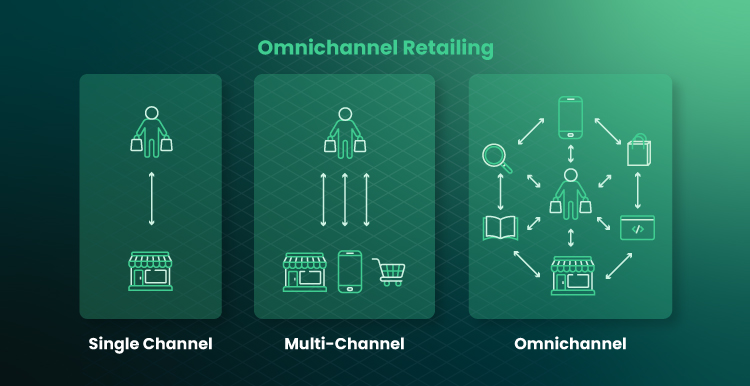
Omnichannel approach: It’s when your client can quickly identify your business at any channel and get the same high-quality and user-centric customer experience no matter the touchpoint.
When to use? When you use different channels for offering the same goods or services, implement the omnichannel marketing strategy. Sales processes, marketing, communication, and product info will be synchronized across all channels and integrated into a comprehensive business ecosystem.
Multichannel approach: It’s when you invest in multiple channels that are independent of one another. Data is not synchronized across channels. Client interaction points may be the same on these channels or may differ significantly.
When to use? A multichannel approach is used when each channel is dedicated to a particular part of your services. If each channel has its own goal and intention, then a successful omnichannel marketing strategy is unnecessary.
Single-channel approach: Single-channel means that a business uses only a single channel for client interactions. Usually, these are offline businesses that implement this approach. A typical example of such a business is a local, offline company that has a limited audience and limited growth opportunities.
When to use? This strategy is used when your business is linked to the place or channel where it runs. It’s either impossible for you to expand or you have no need to. For example, you are a tour guide in your town or city and offer tourists the opportunity to order the tour online via your website. Since your services are based in a particular location, the single-channel approach may be the most convenient method for promoting your business.
Omnichannel Benefits
Omnichannel distribution gives numerous benefits. We outline the most important ones below:
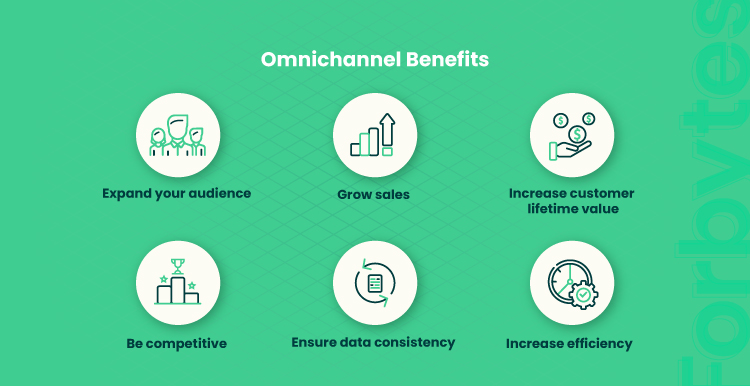
Expand your target audience
This is one of the most important benefits of successful omnichannel marketing strategies. Omnichannel distribution means that you use multiple channels to reach your clients. This, in turn, means higher chances to reach more people who prefer one or another channel.
Increase the customer lifetime value
Retail omnichannel in ecommerce is the strategy that puts the client first. You provide a customer-centric experience and create a sense of the ecosystem in which your client exists. They feel safe and comfortable when switching your channels. This is because they see the same brand identity and the same intention from you throughout their journey. As a result of the omnichannel approach, you can achieve 30% higher customer lifetime value.
Increase efficiency
You can cut operation costs and increase efficiency by implementing omnichannel in ecommerce. There’ll be no need for you to perform the same operations multiple on different channels (for example, collecting customer data). This will be done once and the data will be shared for all channels. And the more sales channels you add to this seamless integration, the less you’ll need to invest in advertising and promotion.
Grow sales
If you use multiple channels for interaction with your clients, you get a higher chance that they will come across your business again and again. At first, they will see your ecommerce website on Google when searching for something. Then, they will come across your Twitter or Instagram page. And then, they will see your brand name on a marketplace or some other platforms. As a result, your brand becomes memorable, and the chances that the client will choose you will grow. The more clients you get, the more you earn.
Be competitive
Even if you postpone the implementation of the omnichannel retail strategy, be aware of the fact that your customers are already omnichannel. For example, people often search for products online before going to a brick-and-mortar store and buying them. If you don’t ensure cross-channel data availability, you are at risk of losing prospective clients. Omnichannel in ecommerce helps vendors win the competition by encouraging their clients to interact with their business multiply.
Ensure data consistency
Nearly 45% of customers expect in-store consultants to be aware of the products that are offered online. With omnichannel, your data on each client is channel-independent. You collect these data across channels and can use them to gain insights into your audience. You can define what channel works the best for a particular client segment, what type of content generates more sales, etc.
Steps for Building a Consistent Omnichannel Strategy
We compiled the list of 7 steps essential for building effective omnichannel marketing strategies. If you need help at any stage of strategy development, our team of dedicated product engineers can help.
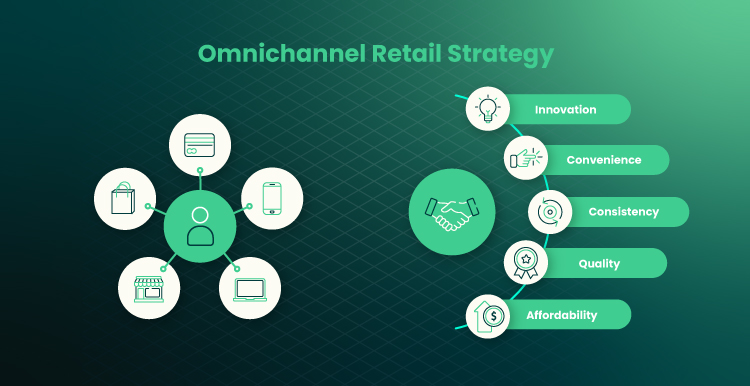
1. Figure out who your client is.
Get to know your client better. Group customers into customer segments and investigate the behavioral patterns and shopping habits of each segment. You can conduct surveys and offer a discount for the clients that complete them. The collected data will help you define effective touchpoints to invest in them more.
2. Explore the customer journey.
Under the perfect scenario, each client interaction with your brand should be shoppable. At any point when they decide to purchase, they should have the opportunity to fulfill this goal in a few clicks.
3. Connect all your channels.
Mind connecting online and in-store experience. Besides, let your users get the omnichannel experience no matter the device and screen type. Statistics show that over 90% of people owning multiple devices switch between them during the day. Also, it’s preferable to offer Wi-Fi Internet access to your offline users. Many customers (nearly 71%) go for online searches when buying in a brick-and-mortar store. It’s much easier for them to find the products using filtering than to wander through the store’s space with numerous product shelves in search of the needed item.
4. Retrain your staff if needed.
If you’ve been implementing a multichannel strategy for a long time, your employees have gotten used to this approach and need to undergo retraining to change their work habits and approaches. This will ensure that they provide the same client service on different channels.
5. Undergo digitalization.
You will need software products to ensure effective cross-channel data management. Our team can help you build solutions for business automation, order fulfillment, and role-based task management.
6. Grow your social media presence.
Modern customers spend a great part of their spare time on social media. To become a part of the client’s daily routine, you should grow your social media presence. On your business pages, leave active links to your product pages to engage the audience that uses this channel for making purchase decisions. Also, encourage your clients to share photos of your products and get some kind of reward.
Bonus step
Integrate interactive technology to ensure a seamless experience for your clients. Interactive technology is what can differentiate you from competitors. Technologies like AR, VR, or AI can facilitate the user journey and make your brand distinguishable.
Omnichannel Approach Tips
These tips will help you make sure that your omnichannel campaign is tailored to your needs and bring you long-term benefits:
- Focus on your client
Start by defining your client needs and then figure out how to use various marketing channels to satisfy these needs. For example, your physical store offers a unique opportunity to consult a stylist. Offer the same on your online store and share stylists’ insights on social media.
- Integrate online and offline channels
Customer expectations today are rising. Modern clients expect businesses to keep their offline and online channels integrated. At least 73% of clients like buying from one business using different channels. Consumers like the opportunity to shop online and pick their orders up in brick-and-mortar locations. This helps them save time spent searching for the product and avoid delivery fees. So, you need to have stock data updated in real-time for all sales channels.
- Focus on your brand and not the channel
In your client’s eyes, all your channels represent not the channels themselves but your brand identity. This is why you need to focus on your brand and try to express your unique features across sales funnels. Omnichannel customers interact with your brand, not your separate channels. They expect your Instagram consultants to be as attentive as your customer support representatives. They expect that they can use social media to view how your products look in real life. And the same stock should be represented on your website.
- Ensure real-time data access 24/7
Your clients and employees should have uninterrupted access to fresh data on various channels. For instance, if some of your products are out of stock, display this information not only on your ecommerce site but also on other channels you use.
- Implement Business Intelligence solutions
For data-driven decision-making, you will need the tools capable of collecting data from all channels. Such tools are used to collect all-encompassing data on clients (behavioral patterns, preferences, shopping habits), sales, marketing strategies, user interaction, competition, and more. With the help of such tools, you can launch AI-powered data analysis and visualization. Data reports will help you make informed decisions on omnichannel strategies and their implementation on various channels. The data will be used to improve customer experience while not compromising efficiency. If you need help with building or integrating BI tools, our software experts are here to help.
Omnichannel Commerce Examples
More and more businesses turn to the omnichannel approach. Such a transformation requires effort from you and much of your time at the start. But in the long run, unifying all your efforts will bring more efficiency and effectiveness to your business. Here are some examples of companies that move toward the omnichannel approach and implement digital solutions that blend offline and online experiences for their clients.
Starbucks

Starbucks is an example of a business that successfully implements the omnichannel strategy. The company puts effort into digitizing customer habits and connecting offline and online experiences. For this, the company built a mobile app available for iPhone and Android. The mobile app is used for ordering coffee online in advance to avoid lines in brick-and-mortar shops. By using the app, clients also can earn points that can be spent on free coffee. This is a game-like experience that attaches users to the business and encourages them to stay with the company. Whenever they have the choice of where to drink coffee, people will preferably choose Starbucks.
Timberland
Timberland utilizes the benefits of beacon technology and near-field communication (NFC) to offer interactive user experiences at their offline shops. The use of cutting-edge technology encourages the clients to engage and interact with their products more, which increases the chance of a successful purchase. Timberland installed the “tap walls” where clients can take a tablet, tap a tag on any product, and instantly get all essential information about the product on the screen. They also can investigate the products offline, create a list of favorites, and send it to their email to make the final purchase decision later.
Sephora
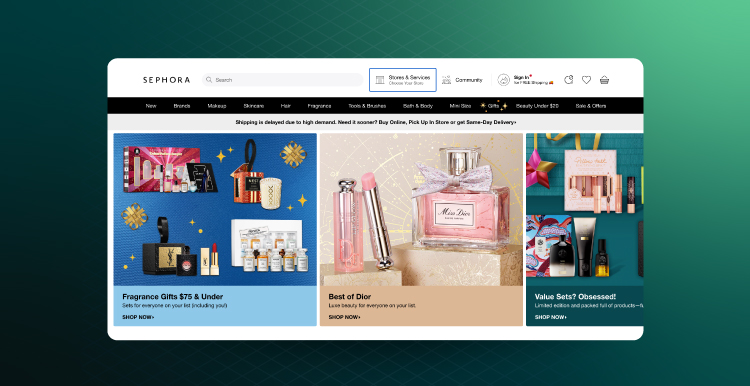
Sephora is an international beauty brand that also applies the omnichannel approach to customer experience. The clients can integrate their offline store visits with their online activity on Sephora’s website. Users can take tablets in the store and access Sephora’s customer accounts. Using the tablet, clients can virtually try on products and check product details. If a customer likes some product, they can add it to their wishlist which will be synchronized in their “Beauty Bag.” The client can turn back to the wishlist later and use the app to make a purchase. As Google notes, nearly 85% of clients start their shopping journey on a desktop or mobile device and finish it on another device. This is how Sephora’s strategy brings the business higher sales.
Future of Omnichannel Retail
Digital experiences bring numerous benefits and save time and effort. Meanwhile, offline experiences give clients the chance to investigate products deeply, enjoy human communication, and avoid extra fees. We assume that the future of retail belongs to omnichannel. Businesses blend offline and online experiences, integrate technology into daily operations, use social media to promote their brands, and more.
Need help with building a robust and future-proof omnichannel strategy for your business or digitizing back-office management as well as client experiences? If so, we are waiting for your note.

Our Engineers
Can Help
Are you ready to discover all benefits of running a business in the digital era?

Our Engineers
Can Help
Are you ready to discover all benefits of running a business in the digital era?






